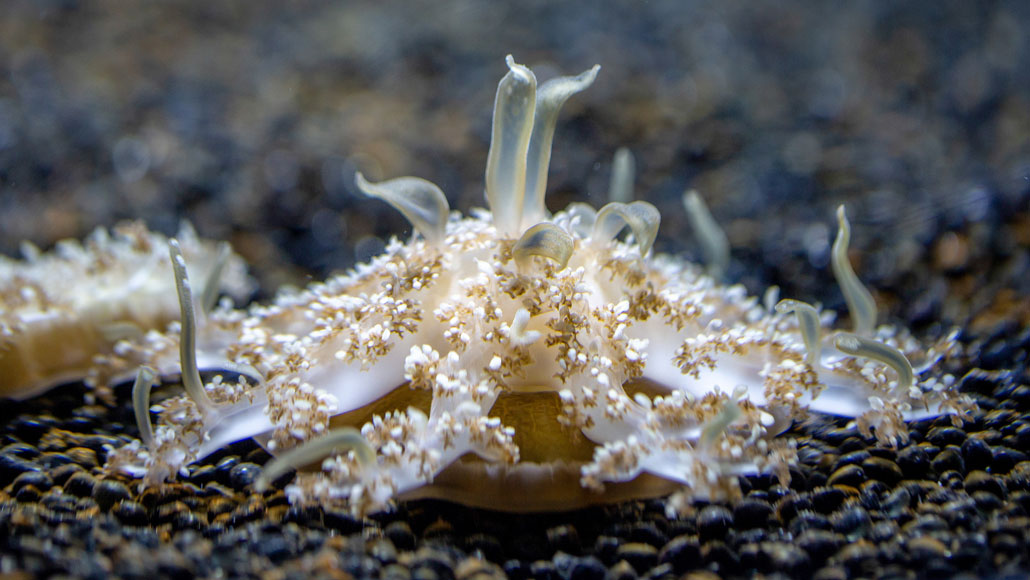Ouch! Jellyfish snot can hurt people who never touch the animal
Upside-down jellies shed mucus that contains blobs lined with stinging cells

Watch out! The upside-down jellyfish pictured here can sting other animals — even humans — remotely. It releases mucus into the surrounding water. And that goo hosts stinging cells.
National Aquarium
Share this:
- Share via email (Opens in new window) Email
- Click to share on Facebook (Opens in new window) Facebook
- Click to share on X (Opens in new window) X
- Click to share on Pinterest (Opens in new window) Pinterest
- Click to share on Reddit (Opens in new window) Reddit
- Share to Google Classroom (Opens in new window) Google Classroom
- Click to print (Opens in new window) Print
Swimmers who feel “stinging water” in some coastal seas may want to blame jellyfish snot. It’s a mucus made by at least one type of upside-down jellyfish. These animals tend to live near mangroves. (Forests of these trees can grow in warm coastal areas where saltwater bathes their lower trunks and roots.)
Upside-down jellyfish get their name for resting, belly-up, on the seafloor. At least one species (Cassiopea xamachana) can sting other creatures remotely — that is, without ever touching them. These jellies release a mucus. Inside the goo are clusters of stinging cells. These cells are known as nematocysts (Neh-MAT-oh-sists). Such cells typically show up on jellyfish tentacles. But here, the cells also turned up in snot drifting away from the jellyfish.
Researchers described the stinging goo February 13 in Communications Biology. This study provides the first explanation for why swimming near upside-down jellies can sometimes cause the skin to feel prickly or like it’s burning.
The stinging cells coat tiny mobile blobs in the mucus. The blobs are called cassiosomes (KASS-ee-oh-soams). In a lab dish, these blobs can “zoom around like a Roomba [vacuum] zapping brine shrimp,” observes Cheryl Ames, She’s a marine biologist at Tohoku University in Sendai, Japan. Her team observed brine shrimp becoming paralyzed shortly after touching a cassiosome. Shortly afterward, the animals died.
C. xamachana jellyfish tend to rest in groups on the seafloor. This lets photosynthetic algae living in their tissues produce nutrients that benefit both the algae and their host. Biologists are not sure how making stinging snot helps jellyfish in the wild. One idea: This goo might help them get prey. Or it might help fend off predators. At least in the lab, upside-down jellyfish spewed clouds of mucus when agitated or eating.
Under the microscopic, this mucus appears to be filled with what Ames calls a “spider web of things” all moving around. Those things included food bits and cassiosomes.
Puzzled, the researchers pored over publications on jellyfish. They turned up one interesting 1908 report. In it, in zoologist Henry Farnham Perkins suggested that the cell clusters in that goo might be parasites. (This was after his theory that they were embryos had been proven wrong.) In the end, Perkins conceded that he was “still quite in the dark as to the nature of these curious bits of animal life.”
Ames and her team have now shown that cassiosomes are hollow cellular masses. Lining their outer surface are those stinging nematocyst cells together with bristle-like cells. That second type of cell helps the stinging cells move within mucus. But the cassiosomes didn’t seem to need the snot. When removed from the goo, they could still move around for up to 10 days.







